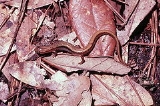
Eurycea quadridigitata
Encyclopedia
The Dwarf Salamander is a species
of salamander
native to the southern United States
, from North Carolina
to Oklahoma
, south to Texas
along the Gulf of Mexico
states to northern Florida
. Some sources refer to it as the Four-fingered Manculus, Dwarf Four-toed Salamander, or the Florida Dwarf Salamander.
and spends most of its time under leaf litter, or forest floor debris. Breeding occurs in the fall, with 12 to 48 eggs
being laid singly or in small clutches attached to submerged debris in shallow, slow moving or still water.
Species
In biology, a species is one of the basic units of biological classification and a taxonomic rank. A species is often defined as a group of organisms capable of interbreeding and producing fertile offspring. While in many cases this definition is adequate, more precise or differing measures are...
of salamander
Salamander
Salamander is a common name of approximately 500 species of amphibians. They are typically characterized by a superficially lizard-like appearance, with their slender bodies, short noses, and long tails. All known fossils and extinct species fall under the order Caudata, while sometimes the extant...
native to the southern United States
United States
The United States of America is a federal constitutional republic comprising fifty states and a federal district...
, from North Carolina
North Carolina
North Carolina is a state located in the southeastern United States. The state borders South Carolina and Georgia to the south, Tennessee to the west and Virginia to the north. North Carolina contains 100 counties. Its capital is Raleigh, and its largest city is Charlotte...
to Oklahoma
Oklahoma
Oklahoma is a state located in the South Central region of the United States of America. With an estimated 3,751,351 residents as of the 2010 census and a land area of 68,667 square miles , Oklahoma is the 28th most populous and 20th-largest state...
, south to Texas
Texas
Texas is the second largest U.S. state by both area and population, and the largest state by area in the contiguous United States.The name, based on the Caddo word "Tejas" meaning "friends" or "allies", was applied by the Spanish to the Caddo themselves and to the region of their settlement in...
along the Gulf of Mexico
Gulf of Mexico
The Gulf of Mexico is a partially landlocked ocean basin largely surrounded by the North American continent and the island of Cuba. It is bounded on the northeast, north and northwest by the Gulf Coast of the United States, on the southwest and south by Mexico, and on the southeast by Cuba. In...
states to northern Florida
Florida
Florida is a state in the southeastern United States, located on the nation's Atlantic and Gulf coasts. It is bordered to the west by the Gulf of Mexico, to the north by Alabama and Georgia and to the east by the Atlantic Ocean. With a population of 18,801,310 as measured by the 2010 census, it...
. Some sources refer to it as the Four-fingered Manculus, Dwarf Four-toed Salamander, or the Florida Dwarf Salamander.
Description
The Dwarf Salamander grows from 2 to 3.5 inches in length. It has a slender body and a long tail. It is typically yellow-brown in color with darker brown blotching and dark stripes down each side, but the pattern and coloration can vary widely. The epithet quadridigitatat is to denote that each of its feet has four toes.Behavior
The Dwarf Salamander prefers habitats of swampy pine woods. It is nocturnalNocturnal animal
Nocturnality is an animal behavior characterized by activity during the night and sleeping during the day. The common adjective is "nocturnal"....
and spends most of its time under leaf litter, or forest floor debris. Breeding occurs in the fall, with 12 to 48 eggs
Egg (biology)
An egg is an organic vessel in which an embryo first begins to develop. In most birds, reptiles, insects, molluscs, fish, and monotremes, an egg is the zygote, resulting from fertilization of the ovum, which is expelled from the body and permitted to develop outside the body until the developing...
being laid singly or in small clutches attached to submerged debris in shallow, slow moving or still water.

